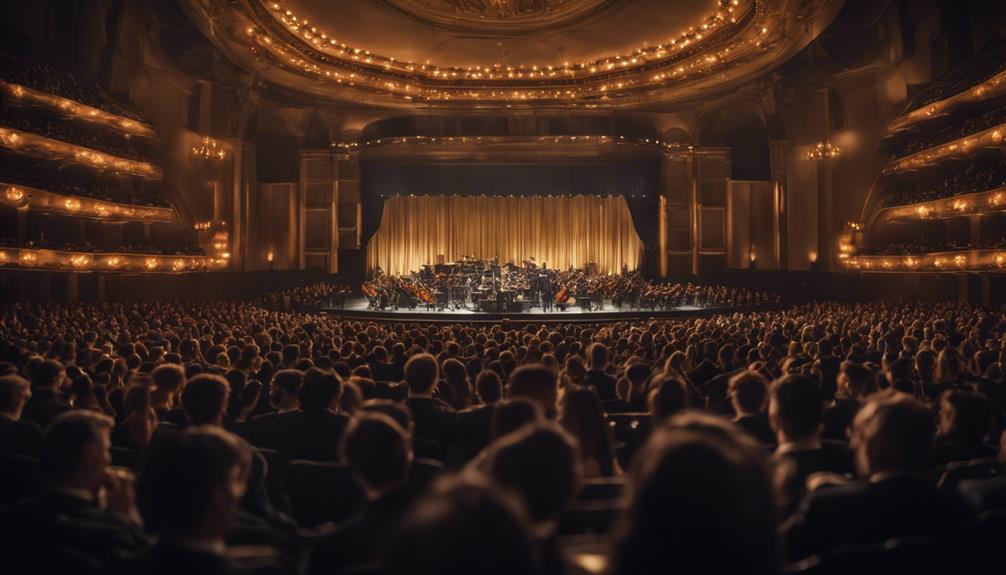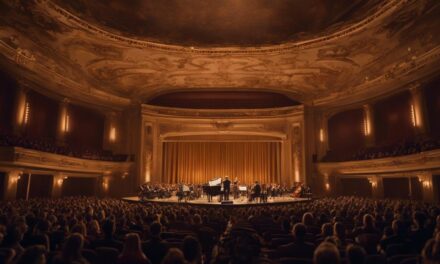Attending a symphony concert is like opening a beautifully wrapped gift—you want to savor every moment. To enhance your concert experience, you should start by checking the concert calendar regularly to plan your visits. Understanding the compositions and focusing on individual instruments can deepen your appreciation. Early ticket purchases not only secure the best seats but also offer opportunities for subscription packages and discounts. Don't forget to brush up on concert etiquette and consider the needs of children if they're joining you. There's much more to explore in this guide, guaranteeing you don't miss any key details.
Key Takeaways
- Regularly check the concert calendar to stay updated on upcoming symphony performances.
- Purchase tickets early to secure the best seating options and avoid last-minute disappointments.
- Explore subscription packages for seasonal savings and exclusive concert perks.
- Utilize student discounts and social media promotions for affordable ticket options.
- Learn about the featured composers and their musical styles to enhance your concert experience.
Check the Concert Calendar
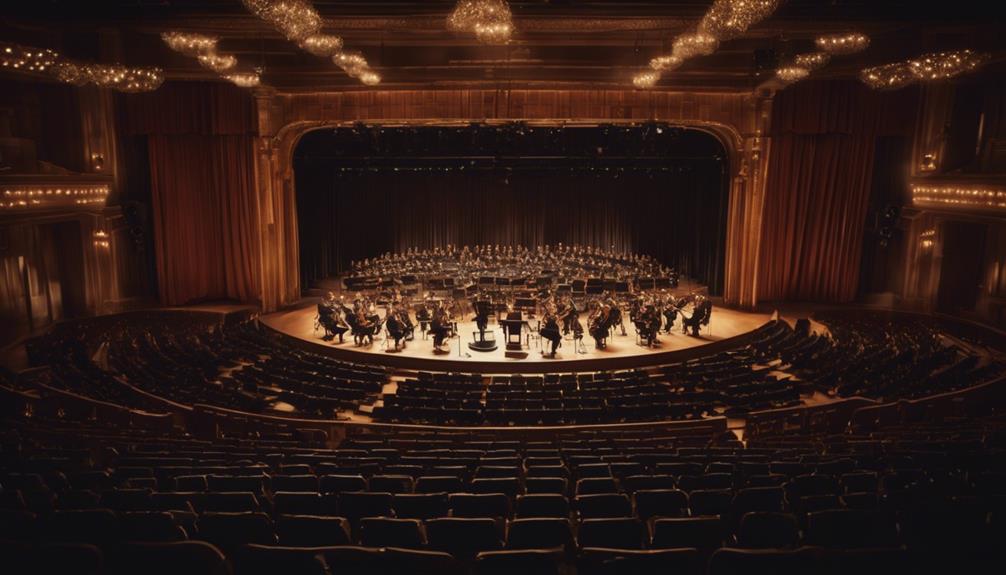
To make the most of your San Francisco Symphony experience, regularly checking the concert calendar is essential for staying informed about upcoming performances and planning your visits. The concert calendar is your gateway to a world of rich musical experiences, revealing the date, time, and venue for each performance. By consulting this resource, you can align your schedule with the symphony's offerings, ensuring you never miss a performance that intrigues you.
Audience members will find the calendar particularly useful for exploring the diverse range of musical styles and guest artists featured throughout the season. Each entry typically includes details about the featured composers and works, often highlighting pieces with multiple movements, which can provide a deeper, more varied listening experience. This level of detail allows you to select concerts based on your personal musical preferences, whether you're drawn to the classics, contemporary compositions, or specific guest artists.
Furthermore, the concert calendar highlights subscription packages available for purchase. These packages offer discounted access to multiple concerts, making it more affordable to enjoy a broad spectrum of performances. Subscribing can be particularly advantageous if you plan to attend several concerts over the season, as it not only saves money but also provides a cohesive, curated musical journey.
Learn About Composers
To deepen your appreciation of the music, start by researching the biographies and stories of the composers featured in the symphony concerts. Understanding their signature musical styles and the historical context behind their works will enhance your listening experience.
Engage with their most significant pieces, and you'll uncover the unique elements that define their contributions to classical music.
Composer Biographies and Stories
Exploring the lives and works of iconic composers like Beethoven, Mozart, and Bach offers a profound understanding of how their personal experiences and historical contexts shaped their timeless masterpieces.
To fully appreciate an entire piece, make sure you investigate the stories behind famous compositions like Beethoven's Symphony No. 9 or Mozart's Requiem. These narratives reveal the emotional depth and innovative spirit that drive their music.
Beethoven, for instance, composed some of his most influential works while grappling with hearing loss, infusing his symphonies with a poignant sense of struggle and triumph. Mozart, a prodigy whose life was cut tragically short, left behind a legacy marked by both dazzling virtuosity and a sense of unfinished potential. Bach's compositions, deeply rooted in his devout Lutheran faith, offer intricate counterpoints that reflect both his religious devotion and technical mastery.
Understanding the backgrounds of these composers enriches your concert experience by illuminating the cultural and personal forces that shaped their music. By learning about their stories, you connect more deeply with the music, appreciating not just the notes, but the context in which they were created. This insight transforms a symphony concert from mere listening into a more immersive and meaningful experience.
Signature Musical Styles
Understanding the unique signature styles of composers like Beethoven, Mozart, and Tchaikovsky allows you to recognize the distinctive musical elements that make their works stand out in the San Francisco Symphony Orchestra's diverse repertoire.
Beethoven's compositions often feature dramatic orchestra dynamics and innovative instrument combinations, creating powerful emotional contrasts. His symphonies, such as the iconic Ninth, are known for their grandiose scale and complex structures, demanding precise conductor interpretations to convey their full depth.
Mozart, on the other hand, is celebrated for his clarity, balance, and form. His works often feature elegant melodies and harmonies, with a transparent texture that highlights individual instruments within the orchestra. The interplay between strings and woodwinds in his symphonies and concertos exemplifies his mastery in blending instrument combinations seamlessly.
Tchaikovsky's music, rich with lush orchestrations and emotional intensity, often employs sweeping melodies and vibrant orchestra dynamics. His ballets and symphonies are filled with passionate themes and colorful timbres, requiring conductors to draw out the expressive nuances and maintain the intricate balance between sections.
Understand the Pieces
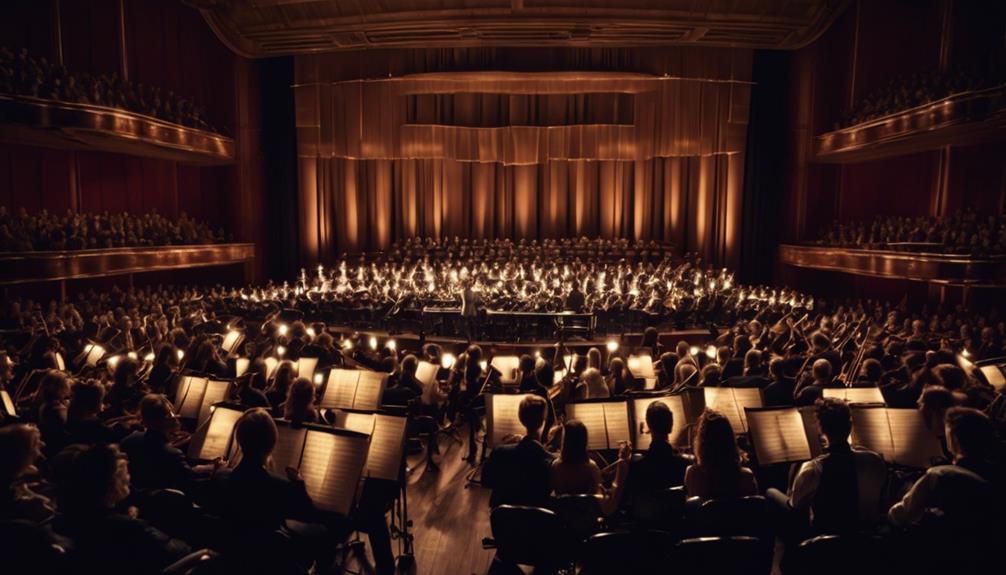
To truly appreciate the music, start by understanding the historical context in which the composer created the piece.
Analyze the key musical themes and how they evolve throughout the movements.
Reflect on the emotional impact these elements might have, enriching your concert experience.
Composer's Historical Context
Diving into the composer's historical context allows you to grasp the intricate tapestry of influences, events, and personal experiences that shaped their music. Start by examining the composer's upbringing. Their early environment, family background, and initial exposure to music often play significant roles in their development.
For instance, some composers were born into musical families, while others discovered their passion despite having no musical lineage.
Next, explore their musical influences. Identifying the mentors, contemporaries, and specific musical traditions that the composer was exposed to can reveal a lot about their style.
Did they study under a renowned maestro? Were they inspired by folk music, or perhaps by the works of earlier composers? These influences often leave an indelible mark on their compositions.
Lastly, consider the historical events that occurred during the composer's lifetime. Wars, revolutions, and societal changes can deeply impact their work.
For example, Beethoven's symphonies reflect the turmoil of the Napoleonic Wars, while Shostakovich's compositions are colored by the oppressive Soviet regime. Understanding these contexts allows you to appreciate the resilience, innovation, and emotional depth in their music, providing a richer concert experience.
Musical Themes Analysis
Grasping the musical themes of the pieces in an upcoming concert involves identifying the key composers and their distinctive styles. Start by exploring the historical context to understand how their environment influenced their music. Dive into recordings or videos to familiarize yourself with the melodies and structural elements. This will help you recognize recurring motifs and themes that the composers frequently use.
During your theme exploration, pay close attention to how these motifs create musical connections between different pieces on the program. For instance, a recurring motif might appear in both the overture and the symphony, providing a cohesive experience throughout the concert. Melody analysis is essential here—break down the main themes and note how they evolve within a piece. Are there variations, or is there a stark contrast between movements?
Attending pre-concert talks or reading program notes can also offer valuable insights. These resources often highlight the composers' inspiration and intentions, enhancing your understanding of the musical themes. Ultimately, this thorough analysis allows you to appreciate the nuanced layers of the performance, making your concert experience richer and more immersive.
Emotional Impact Insights
Understanding the emotional impact of symphonic pieces requires a thorough exploration of the composer's intentions, the historical context, and the intricate elements of the music itself. When you listen to a symphony, consider the era it was composed in—whether it's a romantic, classical, or modern piece, each musical style can evoke unique emotional responses. The historical context often informs the mood and tone of the composition, providing a richer emotional landscape.
Pay attention to the composer's intentions. What story or emotional journey were they aiming to convey? As you listen, notice the tempo, dynamics, and instrumentation. These elements shape the emotional depth and narrative impact of the piece. For instance, a sudden shift in tempo or a crescendo can heighten emotional tension, drawing you deeper into the music's emotional core.
Recurring motifs or themes are also essential; they can evoke specific emotions or memories, creating a stronger emotional connection. By understanding these aspects, you can enhance your listener response, making the symphonic experience more profound and fulfilling.
Focus on Instruments
When you attend a symphony concert, understanding the distinct contributions of each instrument can greatly deepen your appreciation of the performance. By grasping instrument techniques, sound characteristics, and orchestra dynamics, you can access a richer, more immersive experience.
Take strings, for instance. Violins and cellos often carry the melody with their expressive bowing techniques, producing a wide range of sound characteristics from sweet and serene to intense and dramatic. Notice how the first and second violins create a dialogue, adding complexity to the piece. The cellos and double basses provide depth, their lower registers underpinning the harmony, creating a strong foundation for the orchestra.
Woodwinds like flutes and clarinets add color and nuance. Flutes can float above the orchestral texture with their bright, airy sound, while clarinets offer a rich, warm timbre. Observe the way woodwind players use breath control and finger techniques to vary their dynamics and articulations, weaving intricate patterns that enhance the overall musical tapestry.
Brass instruments such as trumpets and trombones bring power and grandeur to the orchestra. Trumpet fanfares can be heroic and bold, while trombones add a majestic, resonant quality. Notice how brass players use their embouchure and slide or valve techniques to achieve precise pitch and dynamic control, contributing to the orchestra's dramatic moments.
Percussion instruments like timpani anchor the rhythm and add dramatic emphasis. The timpani's deep, resonant tones can signal climactic points in the music. Percussionists must have impeccable timing and a keen sense of dynamics to blend seamlessly with the rest of the orchestra.
Listen to Recordings
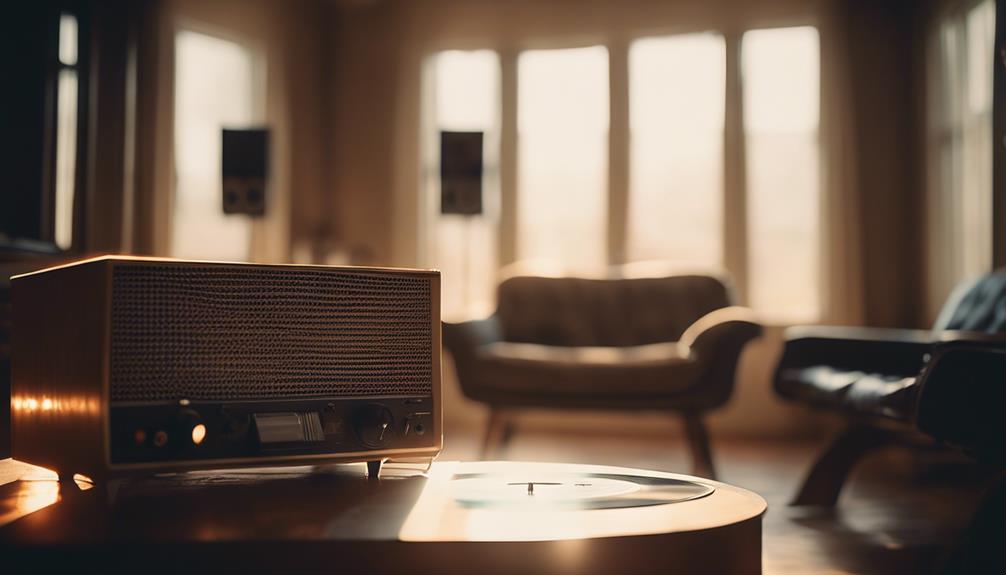
Listening to recordings of the pieces featured in the upcoming symphony concert can greatly enhance your understanding and appreciation of the music. Familiarizing yourself with the dynamics, tempo, and overall feel of the pieces will prepare you to better enjoy the live performance. Online platforms like Spotify, Apple Music, and YouTube make it easy to access a wide range of recordings.
One insightful approach is to compare different conductors' interpretations of the same piece. Each conductor brings their unique vision and style, which can markedly alter the music's character. By listening to various versions, you'll gain a deeper understanding of the piece's potential and the range of emotions it can evoke. Pay attention to how different orchestras balance the instruments and manage tempo changes, as these nuances can profoundly impact your listening experience.
Another aspect to ponder is sound quality comparisons. Modern high-fidelity recordings provide a pristine listening experience, capturing subtle details that might get lost in older recordings. However, historical recordings offer invaluable insight into how the piece was perceived and performed in its own time. They often feature legendary conductors and musicians whose interpretations have set benchmarks for generations.
Historical recordings can also reveal how performance practices have evolved. For instance, you might notice differences in phrasing, articulation, or even the use of certain instruments. This historical context enriches your understanding and connects you more deeply to the music's heritage.
Purchase Tickets Early
To maximize your symphony experience, purchase your tickets early. This not only gives you access to the best seating options but also lets you take advantage of early bird discounts.
With popular performance dates often selling out quickly, planning ahead guarantees you won't miss out on must-see concerts.
Best Seating Options
Securing the best seats for a symphony concert involves understanding the distinct advantages of different seating options and purchasing your tickets early to avoid missing out. Your seating preferences will shape your experience greatly.
If you crave an immersive encounter, orchestra level seats are ideal. They provide close proximity to the musicians, allowing you to feel the pulse of the performance. However, if a full-stage view is more appealing, loge or tier seats offer an expansive perspective, letting you take in the entire orchestra's grandeur.
Acoustic considerations are essential. Some sections, like the terrace, offer a unique behind-the-orchestra perspective, presenting a different acoustic experience. This vantage point can enhance your auditory delight, though it mightn't offer the best sightlines.
Evaluating the sightline importance and proximity benefits is vital. Loge seats, for example, balance clear views with decent acoustics, making them a versatile choice.
Early Bird Discounts
While selecting the right seats is important for your symphony experience, purchasing tickets early can provide significant savings through early bird discounts. These discounts are often offered in limited quantities, meaning the sooner you act, the better your chances of securing these savings. By checking the official website of the symphony, you can stay informed about early bird deadlines and the specifics of these offers.
Acting promptly can make a substantial difference in your overall expenditure. Early bird discounts are designed to reward those who plan ahead, offering reduced prices on ticket purchases. The savings on ticket prices can add up, allowing you to allocate your budget to other aspects of your concert experience, such as dining out or purchasing a program.
It's also worth noting that these discounts aren't available indefinitely. They've specific deadlines, and once the allocated discount tickets are sold out, the opportunity is gone. Hence, it's important to act quickly and monitor the official website closely for the latest updates on discount availability.
Popular Performance Dates
Grabbing tickets early for popular performance dates like opening nights or holiday concerts can make all the difference in securing your spot at these high-demand events. Popular dates tend to sell out quickly, so ensuring ticket availability means acting fast.
Here's how you can stay ahead of the game:
- Subscribe or Join a Membership: Many symphony orchestras offer subscription services or memberships that provide priority access to tickets. This can be a game-changer, giving you the chance to purchase tickets before they go on sale to the general public.
- Monitor Announcements: Keep an eye out for announcements about special guests or unique collaborations. These events often draw larger crowds, making tickets harder to come by. Knowing about these in advance can give you an edge.
- Regularly Check the Schedule: Consistently checking the concert schedule allows you to plan and act quickly. Many people miss out simply because they weren't aware of the dates in advance.
Consider Subscription Packages
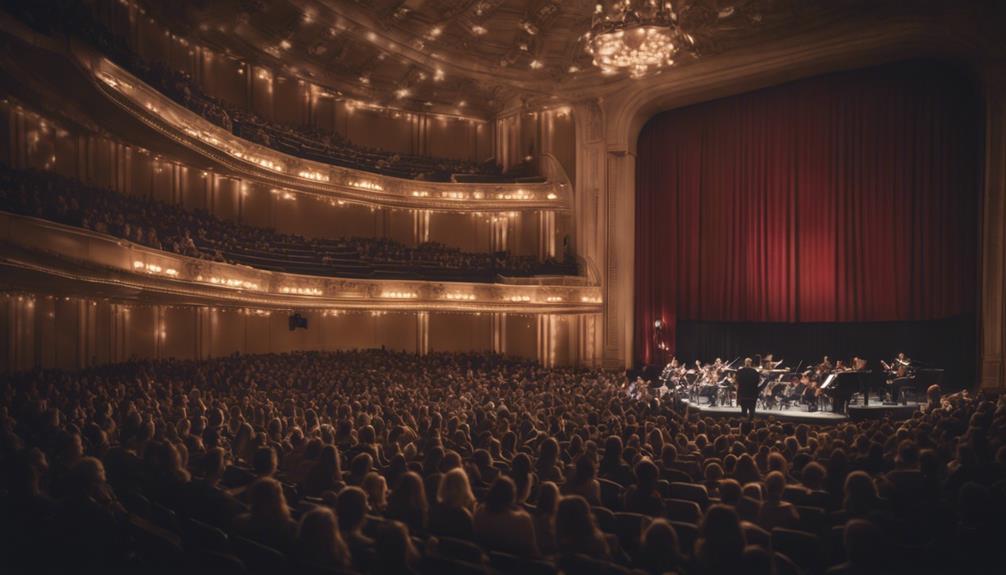
Opting for subscription packages can enhance both your concert-going experience and the value you receive throughout the season. When you commit to a subscription, you reveal a myriad of subscription benefits that elevate your overall experience.
One of the most notable advantages is seasonal savings. Subscribing to a series of concerts often results in a lower cost per ticket compared to purchasing them individually. This financial benefit can be particularly appealing if you plan on attending multiple performances.
Beyond the savings, subscribers frequently gain exclusive access to various perks. Priority seating is a significant draw, guaranteeing that you get the best views of the performance. This early access to prime seats can make a substantial difference, especially for high-demand concerts. Additionally, many subscription packages offer flexibility through ticket exchanges, allowing you to swap dates if your plans change. Subscribers may also receive invitations to special events, such as meet-and-greets with the musicians or behind-the-scenes tours, further enriching your symphony experience.
Subscription packages come in various tiers, catering to different needs and budgets. Whether you're interested in a full-season commitment or prefer a curated series focusing on specific themes or composers, there's likely an option that aligns with your preferences. This flexibility ensures that you can find a package that suits your schedule and musical tastes.
Moreover, subscribing provides a convenient and reliable way to secure tickets to in-demand performances. Knowing you have a guaranteed seat for each concert in your series allows for a stress-free and consistent concert-going experience.
Essentially, a subscription package not only offers financial and logistical benefits but also deepens your connection with the symphony community.
Look for Discounts
Hunting for discounts can greatly reduce the cost of attending symphony concerts without compromising your experience. Leveraging the right discount strategies can make a night at the symphony both affordable and enjoyable.
Here are some insightful tips to help you find the best deals:
- Student Benefits: If you're a student, you're in luck. Many symphonies, including the SF Symphony, offer substantial student discounts. Check their website for special promotions and discounted rates tailored specifically for students. These benefits can make high-quality music accessible without breaking the bank.
- Social Media Promotions and Exclusive Offers: Don't underestimate the power of social media. Follow the SF Symphony on platforms like Facebook, Twitter, and Instagram. They often post exclusive offers and last-minute deals that you won't find anywhere else. Keeping an eye on their feeds can lead to significant savings.
- Community Partnerships and Local Businesses: Explore partnerships between the symphony and local businesses. These collaborations often result in discounts and promotions for concert tickets. Whether it's a local café offering a discount with a concert ticket purchase or a community event featuring reduced concert prices, these partnerships can provide valuable savings.
Beyond these strategies, consider joining organizations like the SF Symphony's Young Patron Circle. Membership often includes access to discounted tickets and special events, adding layers of value to your concert-going experience.
Follow Concert Etiquette

Mastering concert etiquette not only enhances your own experience but also shows respect for the musicians and fellow audience members. Proper etiquette starts with understanding audience behavior. The most essential rule is knowing when to applaud. Applauding at the right time conveys your appreciation without disrupting the flow of the performance. Follow the clapping rules: wait until the end of a complete piece before you clap. Symphony movements can be deceptive; just because the music pauses doesn't mean it's time to applaud. Watch the conductor for cues and observe the majority of the audience if you're unsure when to clap.
Maintaining the atmosphere of the concert is vital. This means minimizing distractions. Silence your electronic devices before the performance starts. A ringing phone or the glow of a screen can break the concentration of both the performers and other audience members. Proper etiquette also includes being mindful of your actions during the performance. Avoid whispering, rustling through bags, or unwrapping candies. These small noises can be surprisingly disruptive in a quiet hall.
If you're bringing children, make sure they understand the importance of concert etiquette. This isn't just about following rules; it's about fostering a deeper appreciation for the music and the effort behind it. Explain the significance of clapping rules and the need to stay quiet and attentive during the performance. By modeling and teaching proper behavior, you contribute to a respectful and enjoyable environment for everyone. Remember, your attentiveness and respect add to the collective experience, making the concert memorable for all.
Plan for Children
Understanding concert etiquette is especially important when you plan to bring children to a symphony performance. Taking the time to prepare can make the experience enjoyable for both you and your kids. Here are some strategies to keep in mind:
- Look for child-friendly activities: Many symphonies offer concerts specifically designed for younger audiences. These performances often include engaging storytelling, familiar tunes, and shorter durations to keep children entertained. Check the symphony's schedule for family-friendly concerts or events.
- Explore interactive programs: Some symphonies offer interactive programs where children can learn more about music and instruments in an engaging way. These might include pre-concert activities like instrument petting zoos, where kids can touch and play different instruments, fostering a deeper connection with the music they're about to hear.
- Participate in educational workshops: Educational workshops can be a great way to prepare children for the concert. These workshops often provide background information about the music, composers, and instruments featured in the performance. This knowledge can enhance their appreciation and understanding, making the concert more meaningful.
Additionally, it's important to check the symphony's age recommendations for concerts. Some performances may be more suitable for older children, while others are tailored for younger audiences.
Arrive early so your children can get accustomed to the concert hall and seating arrangements, reducing the likelihood of disruptions. Also, consider bringing headphones or earplugs if your child is sensitive to loud noises.
Lastly, encourage your children to dress comfortably yet appropriately for the event. This will help them feel at ease and enjoy the performance. By planning ahead and keeping these tips in mind, you can create a memorable and enriching symphony experience for your family.
Frequently Asked Questions
What Should I Wear to a Symphony Orchestra Concert?
To a symphony orchestra concert, adhere to dress codes by wearing formal or semi-formal attire. Men, choose a dark suit or tuxedo with a dress shirt and tie. Women, opt for a floor-length formal dress or a dressy pantsuit. Consider seasonal attire, like lighter fabrics for summer.
Keep accessory choices minimal and tasteful to complement the elegant atmosphere. Avoid casual attire to show respect for the performers.
What Are the 4 Elements of a Symphony?
When you explore a symphony, you'll find four key elements: strings, woodwinds, brass, and percussion. Each section plays distinct roles.
Strings lay the foundational melody, while woodwinds and brass add color and harmony. Percussion enhances rhythm and dynamics.
Historically, composers craft symphony movements with these instruments in mind, creating rich, textured musical experiences that reflect their era's context and innovation.
What Is Proper Concert Etiquette for a Symphony Orchestra Concert?
Proper concert etiquette for a symphony orchestra concert involves precise applause timing—clap only after complete pieces when the conductor signals.
Read program notes beforehand to understand the flow.
If you're a late arrival, wait for a break between movements to enter.
Don't use electronic devices during the performance to respect performers and audience members.
These actions guarantee you blend seamlessly into the concert atmosphere.
What Is the Best Key for a Symphony?
When considering the best key for a symphony, you should look at historical context, emotional impact, and composer preferences.
C major is popular for its simplicity, while D major and E flat major offer a bright and bold sound.
G major and A major keys are uplifting, whereas F major and B flat major provide warmth.
Minor keys like D minor and A minor deliver drama and intensity.
Ultimately, the best key varies by the composer's intent.

